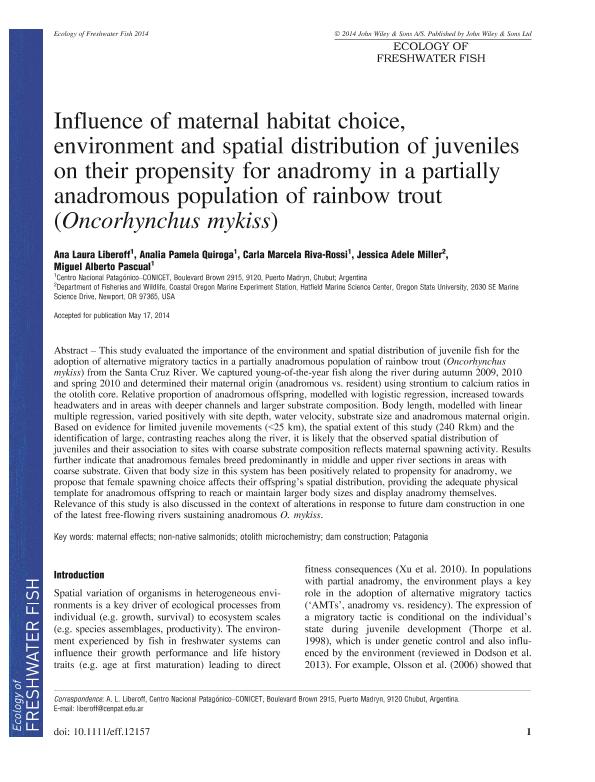Artículo
Influence of maternal habitat choice, environment and spatial distribution of juveniles on their propensity for anadromy in a partially anadromous population of rainbow trout (Oncorhynchus mykiss)
Liberoff, Ana Laura ; Quiroga, Analía Pamela
; Quiroga, Analía Pamela ; Riva Rossi, Carla Marcela
; Riva Rossi, Carla Marcela ; Miller, Jessica Adele; Pascual, Miguel Alberto
; Miller, Jessica Adele; Pascual, Miguel Alberto
 ; Quiroga, Analía Pamela
; Quiroga, Analía Pamela ; Riva Rossi, Carla Marcela
; Riva Rossi, Carla Marcela ; Miller, Jessica Adele; Pascual, Miguel Alberto
; Miller, Jessica Adele; Pascual, Miguel Alberto
Fecha de publicación:
26/07/2015
Editorial:
Wiley Blackwell Publishing, Inc
Revista:
Ecology Of Freshwater Fish
ISSN:
0906-6691
Idioma:
Inglés
Tipo de recurso:
Artículo publicado
Clasificación temática:
Resumen
This study evaluated the importance of the environment and spatial distribution of juvenile fish for the adoption of alternative migratory tactics in a partially anadromous population of rainbow trout (Oncorhynchus mykiss) from the Santa Cruz River. We captured young-of-the-year fish along the river during autumn 2009, 2010 and spring 2010 and determined their maternal origin (anadromous vs. resident) using strontium to calcium ratios in the otolith core. Relative proportion of anadromous offspring, modelled with logistic regression, increased towards headwaters and in areas with deeper channels and larger substrate composition. Body length, modelled with linear multiple regression, varied positively with site depth, water velocity, substrate size and anadromous maternal origin. Based on evidence for limited juvenile movements (<25 km), the spatial extent of this study (240 Rkm) and the identification of large, contrasting reaches along the river, it is likely that the observed spatial distribution of juveniles and their association to sites with coarse substrate composition reflects maternal spawning activity. Results further indicate that anadromous females breed predominantly in middle and upper river sections in areas with coarse substrate. Given that body size in this system has been positively related to propensity for anadromy, we propose that female spawning choice affects their offspring's spatial distribution, providing the adequate physical template for anadromous offspring to reach or maintain larger body sizes and display anadromy themselves. Relevance of this study is also discussed in the context of alterations in response to future dam construction in one of the latest free-flowing rivers sustaining anadromous O. mykiss.
Archivos asociados
Licencia
Identificadores
Colecciones
Articulos(CCT-CENPAT)
Articulos de CTRO.CIENTIFICO TECNOL.CONICET - CENPAT
Articulos de CTRO.CIENTIFICO TECNOL.CONICET - CENPAT
Citación
Liberoff, Ana Laura; Quiroga, Analía Pamela; Riva Rossi, Carla Marcela; Miller, Jessica Adele; Pascual, Miguel Alberto; Influence of maternal habitat choice, environment and spatial distribution of juveniles on their propensity for anadromy in a partially anadromous population of rainbow trout (Oncorhynchus mykiss); Wiley Blackwell Publishing, Inc; Ecology Of Freshwater Fish; 24; 3; 26-7-2015; 424-434
Compartir
Altmétricas



